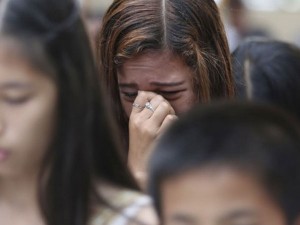
A typhoon survivor breaks into tears in a memorial rites to mark one month since Supertyphoon “Yolanda” (Haiyan) hit the country inside the Palo Cathedral in Palo, Leyte province, on Dec. 8, 2013. AP FIILE PHOTO
MANILA, Philippines—The United Nations and partner organizations have stepped up efforts to protect typhoon survivors in Eastern Visayas from human trafficking, aiming to save the vulnerable from becoming twice the victim in the hands of predators on the prowl.
A coalition of nearly a hundred agencies and local and international organizations, jointly led by the office of the UN High Commissioner for Refugees (UNHCR) and the Department of Social Welfare and Development, have been making the rounds of villages in the so-called “Yolanda corridor” to spread awareness about the perils of taking enticing job offers from strangers.
“We know by experience that when communities are vulnerable, completely uprooted, living in destroyed barangays, predators are very quick and very smart to get into these communities to promise false jobs, all kinds of promises and people are (attracted) by prospects of improving their economic livelihood,” said Bernard Kerblat, head of the UNHCR office in the Philippines.
“We’ve got to make sure that people are empowered to understand what is at stake here and not to give in to some kind of false promises of jobs overseas… We know how it works, and we’re trying to sort of outbid, if you want, the unscrupulous people who may think of exploiting the vulnerability of your kababayans (countrymen) who were affected by Typhoon Yolanda,” he told the Inquirer.
The risk of human trafficking among those who had lost homes and livelihood due to the deadly Nov. 8 supertyphoon has been a concern since the onset of international response to the disaster, with officials citing incidents in previous humanitarian emergencies.
The typhoon affected 14 million people, at least four million of whom were displaced.
“We’re trying to do as much as possible [from the] national level down at the barangay level, at the sitio (community), at the purok (district) level, to talk to these people to say beware that these [predators] may be coming your way,” Kerblat said.
“So before you entrust your child, your daughter to somebody you may not know, think it twice and ask the following question: What is behind this kind of offer? There is no such a thing as a free employment offer going overseas,” said the official.
Kerblat spoke about a recent incident where a “random person” was caught herding out a group of seven minors at the port in Guiuan, Samar. He said police readily separated the minors from the man and separately asked each one about where they were going and what they planned to do at their destination.
“We never found out the bottom line. We never found out what was the story in terms of where they were going, but the thing is, we managed to reunite [the minors] with their relatives in their barangays,” said Kerblat.
He called the incident an “attempt [at human smuggling] that is difficult to prove, but all the suspicions were towards that.”
Police found out that “there was no real plan” on where the group was going, but the man was let go after around “two to three hours” of discussion as there was not enough evidence to charge him.
He was, however, “properly lectured [that] whatever your intentions are, please leave these people alone if they are not your relatives or friends,” Kerblat said.
Hoping to avert similar incidents, Kerblat said the protection strategy involves “sensitization” of affected villages about the trafficking threat, as well as the close involvement of the military, police and the Philippine government’s inter-agency body against trafficking.
“It’s much more than an awareness campaign. It is distribution of information, it is distribution of messages, it is the use of local radio stations, it is also presence in these barangays, talking to people, to communities directly,” said Kerblat.
Authorities are also running stations at departure points in affected villages to register people who had decided to relocate.
“That’s their right and that’s OK to find solutions on their own outside the disaster area through relatives friends and so on… At least we register them so at least we know where they come from, where they go to, and we keep a trace of them,” said Kerblat.
RELATED STORIES:
Typhoon-hit areas watched for traffickers
Singaporean, 2 women nabbed for trafficking
UN says human trafficking found in 118 countries